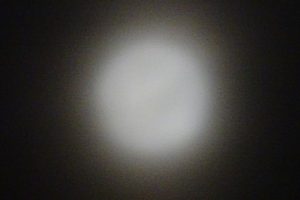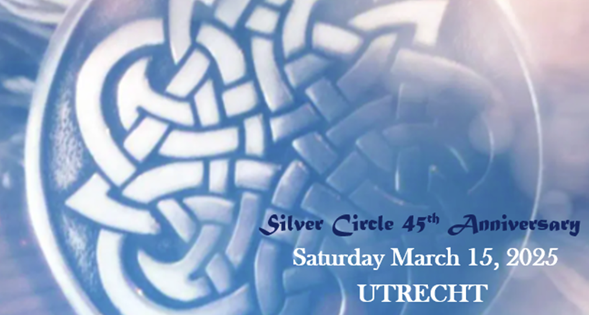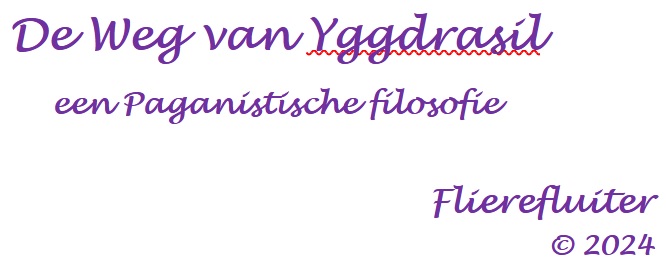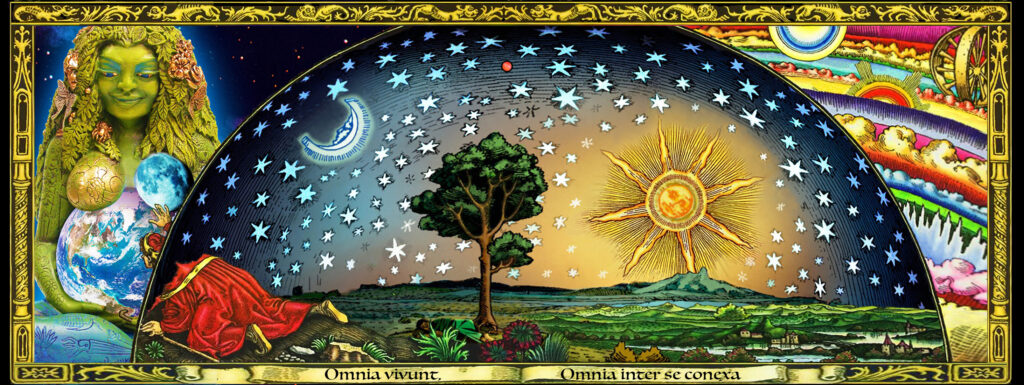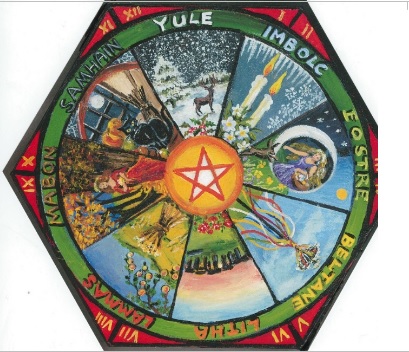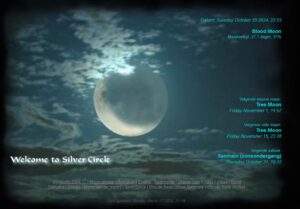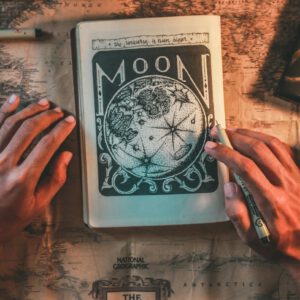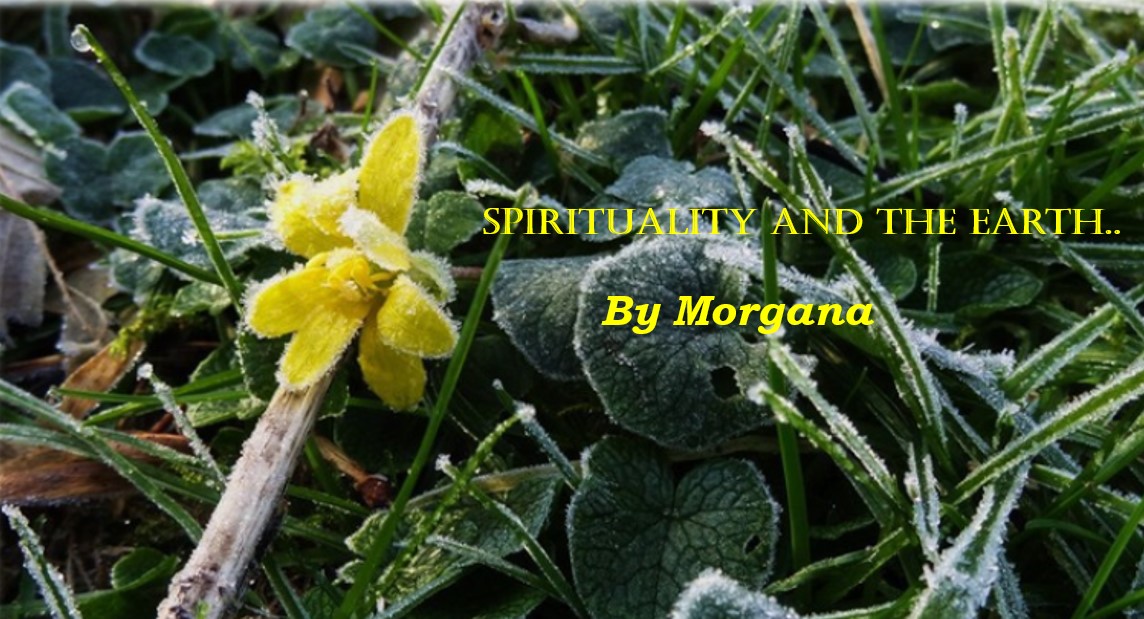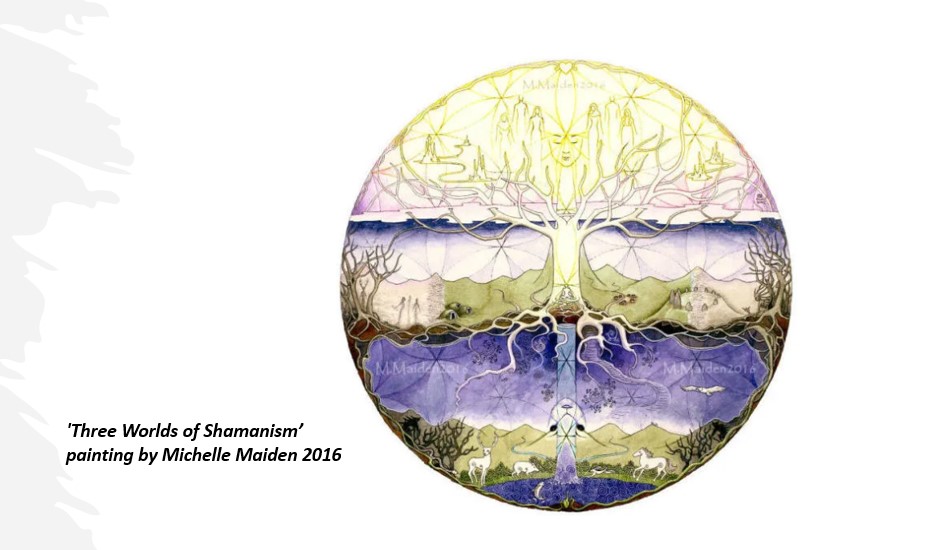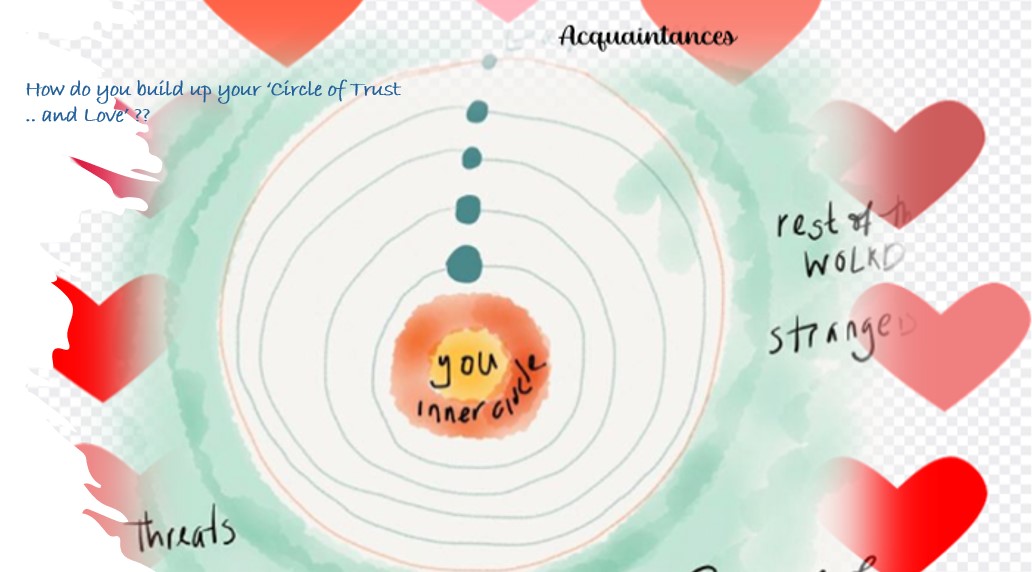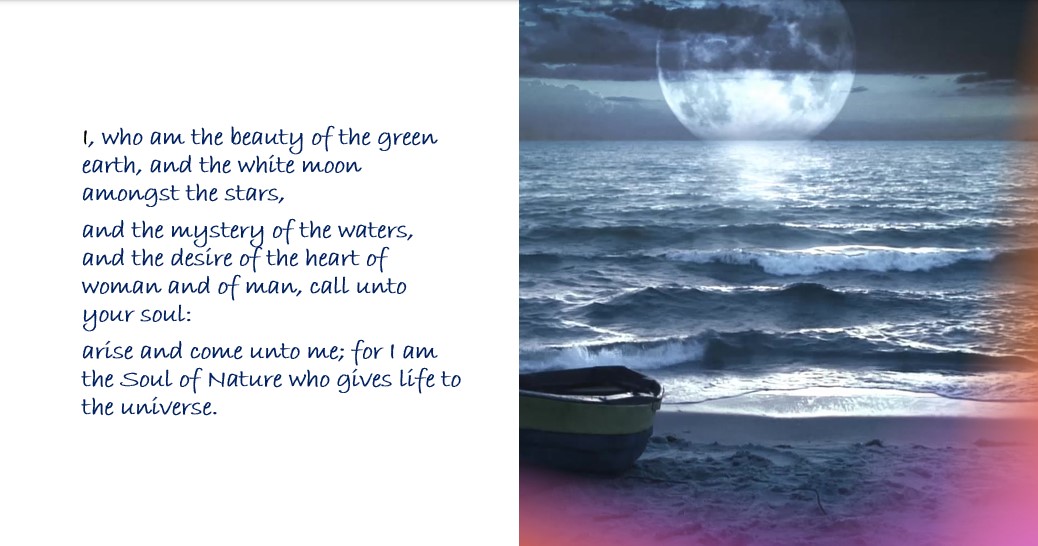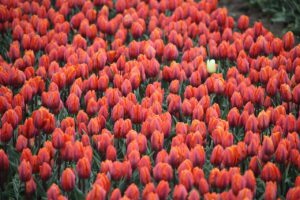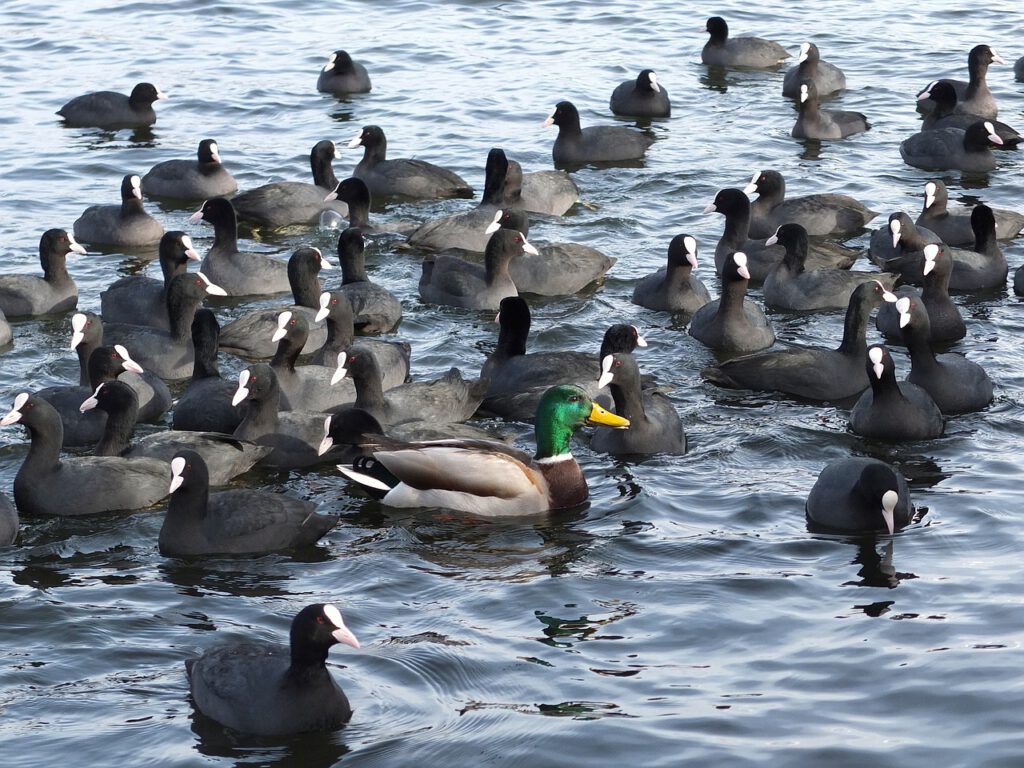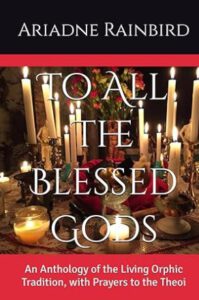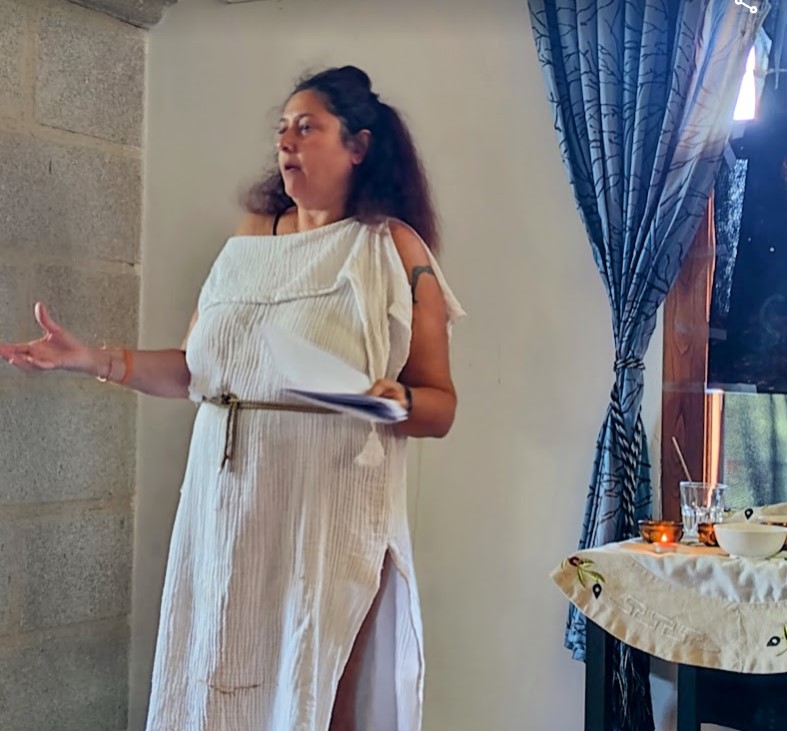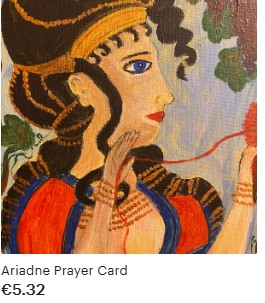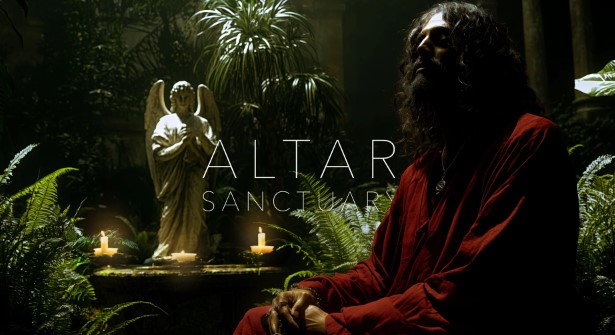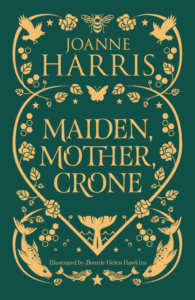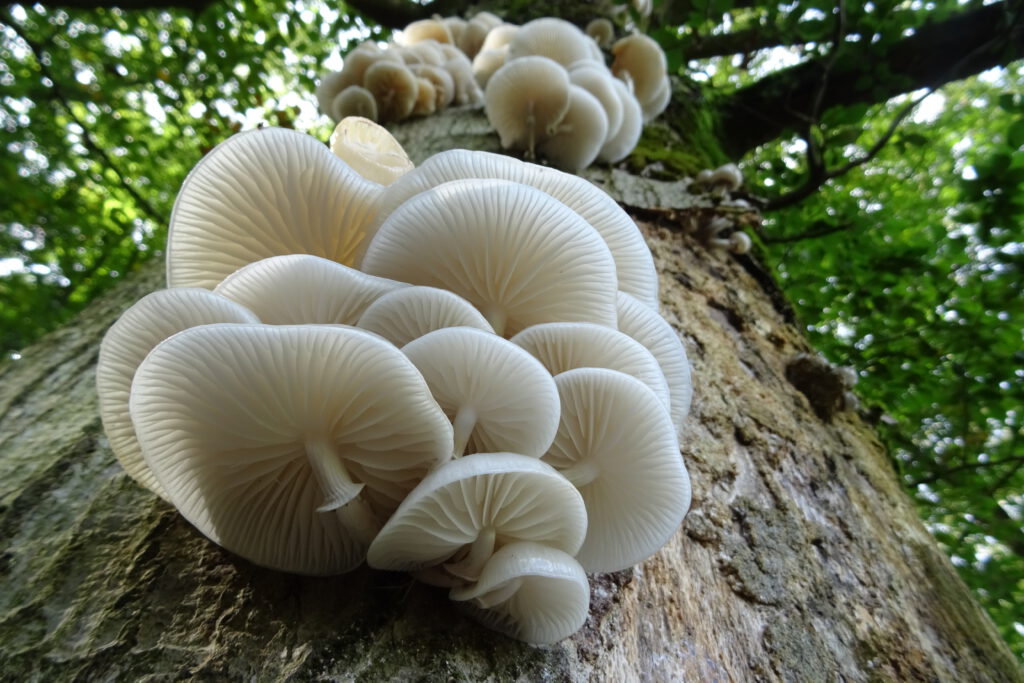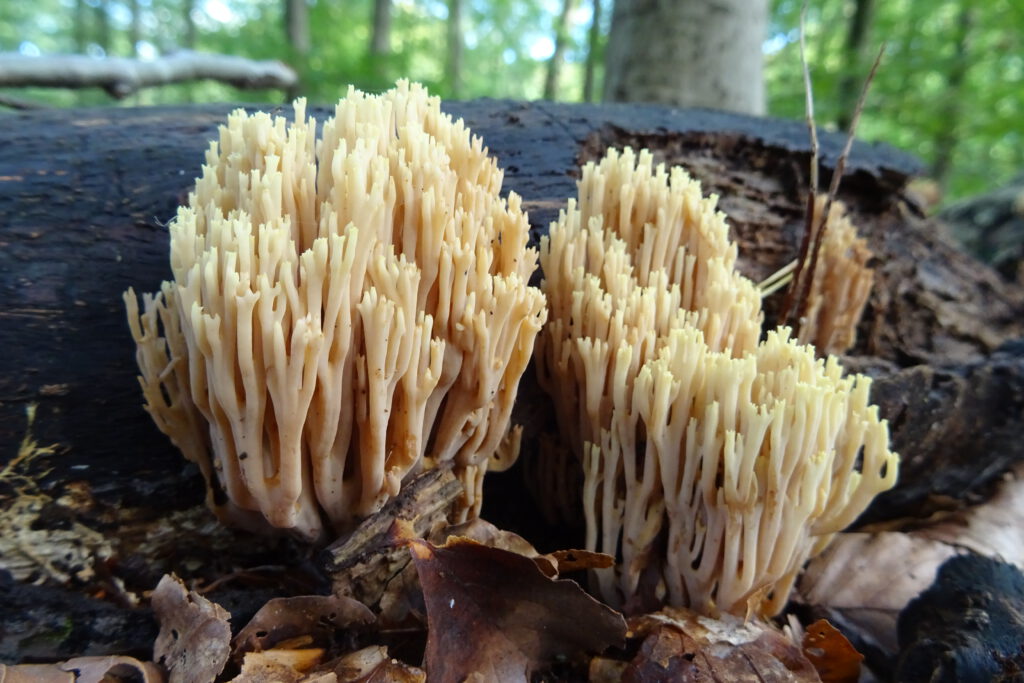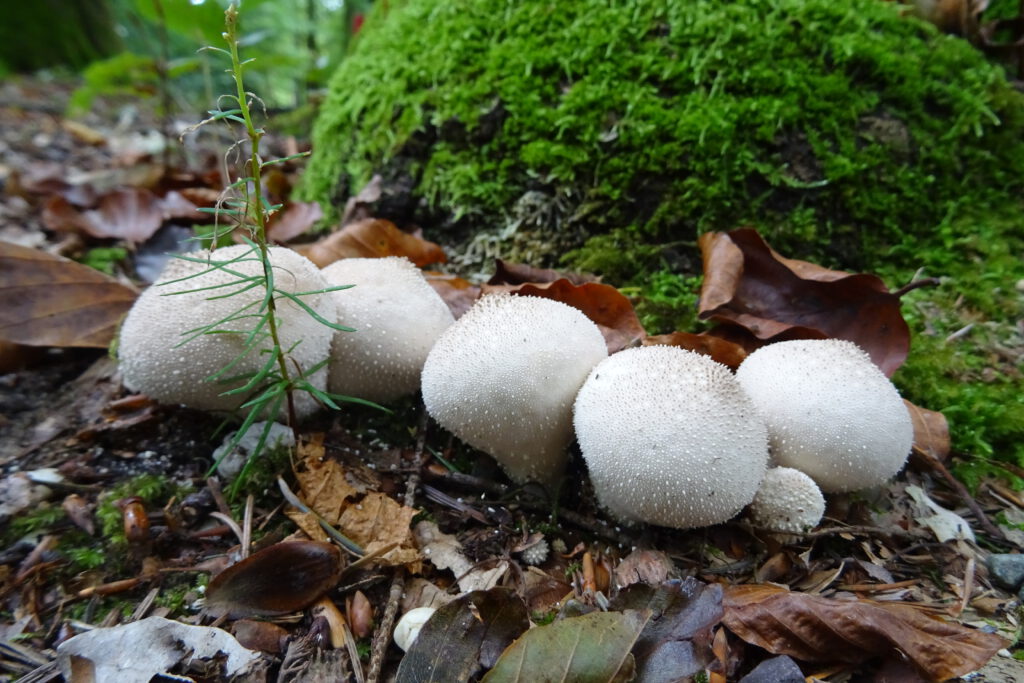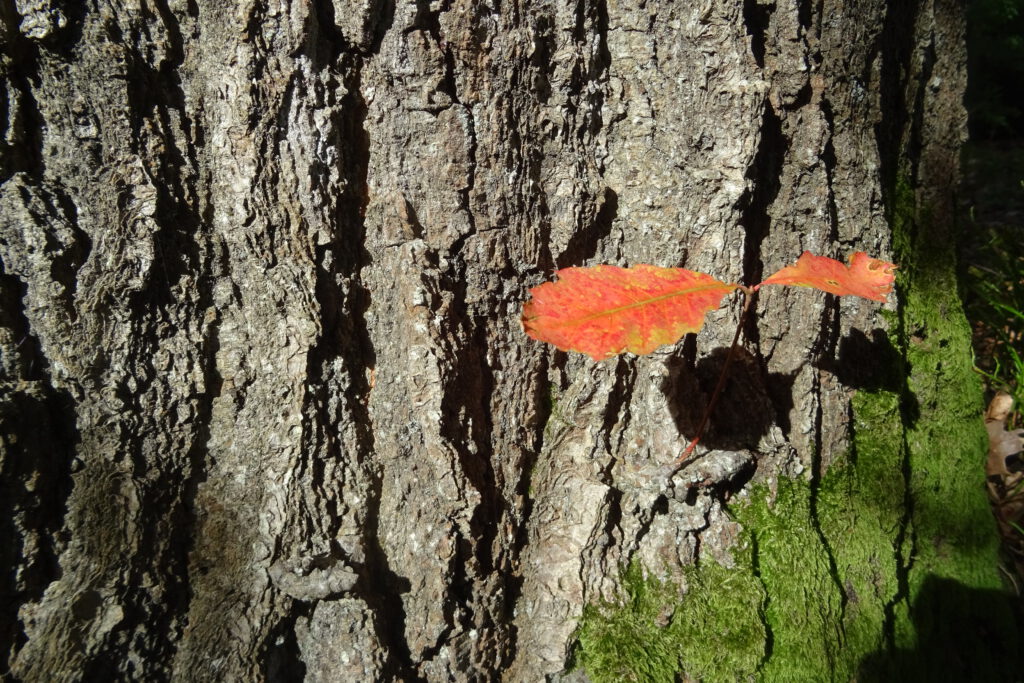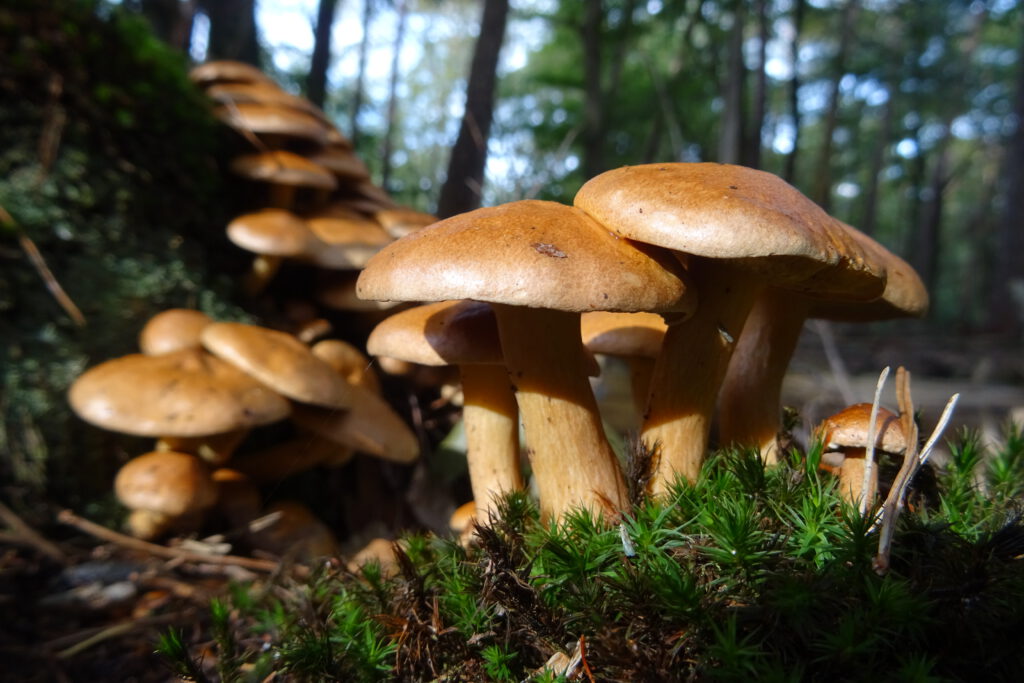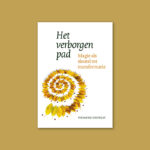Vervolg van de Weg van Yggdrasil, deel 1

Flierefluiter
© 2024
INLEIDING deel 2
“It is only through mystery and madness
that the soul is revealed”
Thomas Moore
Het leven is een mysterie, een knettergek en mooi mysterie. Ik leef nu zo’n 53 jaar en ik blijf me verbazen over alles wat ik meemaak, hoor, zie, ruik, voel en ervaar.
Ik bewandel ook al ruim 30 jaar een paganistisch pad, als Gardnerian Wicca, als heks en als druïde en ik probeer het leven vanuit paganistisch perspectief te beleven, te beschouwen en enigszins te begrijpen. Hiernaast ben ik ooit gegrepen door het Daoïsme en ook deze filosofie vormt een belangrijk denkraam waardoor ik naar het leven kijk.
En hoewel ik inmiddels pretendeer enige wijsheid te hebben opgedaan, blijft het leven een mysterie. Grote gebeurtenissen als geboorte en dood, de wonderbaarlijke veelvormigheid van de Aarde, haar kringlopen en bewoners en het wezen van de Kosmos blijven ongrijpbaar voor me. De daoïstische filosoof Zhuang Zi schreef al: “Met een kikker in een put kan men niet over de zee praten; hij is beperkt tot zijn put. Met een zomerinsect kan men niet over ijs praten, want hij is gelimiteerd wat de tijd betreft.” Het is duidelijk, ik ben een kikker in een put.
En toch wil ik het in dit essay hebben over dit soort grote onderwerpen en vragen. Want ondanks dat we deze mysteriën onmogelijk kunnen bevatten, kunnen we er wel een kleine glimp van opvangen. De kikker in de put snapt de zee niet, maar kent wel het water dat zowel in zijn put als in de zee aanwezig is. Het zomerinsect zal nooit ijs ervaren, maar wel het verschil in temperatuur tussen een plekje in de zon en een plekje in de schaduw.
Ik wil in dit essay delen hoe ik tegen de mysteriën aankijk, welke glimpen ik heb opgevangen en wat dat betekent voor mijn leven, mijn in de wereld staan, mijn handelen en mijn spiritualiteit. Want in mijn ervaring zijn de kleine glimpen van het mysterie die we opvangen, de kleine openbaringen en inzichten die we ontvangen vaak heel betekenisvol en soms zelfs ‘life-changing’.
Ten overvloede wil ik nog benadrukken dat de inzichten die ik hier beschrijf mijn inzichten zijn. Ik ben er van overtuigd dat ze op dit moment voor mij waar zijn en dat het voor iedereen waardevol kan zijn om er hier kennis van te nemen. Ik ben er ook van overtuigd dat ze geen universele geldigheid bezitten maar voor verschillende mensen anders kunnen zijn. Mysteries zijn immers net als olifanten, als je er van de ene kant naar kijkt zie je een slurf die gras eet en als je van de andere kant kijkt een groot gat waar poep uit komt. En beide visies zijn even waar.
Ik wens iedereen veel leesplezier en inspiratie met dit essay!
Blessed Be & /I\
Flierefluiter

Afb. Oberon Zell (naar Flammarion)
DE WERELD OMARMEN
Zoals ik hierboven al schreef denk ik dat de zin van mijn leven is om zo goed mogelijk te leven naar mijn natuurlijke aard, mijn Ware Wil, en zo mijn Weg te gaan. Ik denk ook dat mediteren en mezelf verbinden met energieën als Nwyfre en Awen belangrijke hulpmiddelen zijn om dit te doen. Maar uiteindelijk speelt het leven zich niet af op een meditatiekussen voor een altaar, maar in de wereld. In een Ierse mythe wordt gezegd dat iemand alleen wijs kan worden als hij/zij drinkt uit de heilige bron èn uit de vijf stromen die hieruit ontspringen en die de vijf zintuigen vertegenwoordigen. De fysieke, aardse wereld is immers waar de fun is en de shit happens.
Veel religies beschouwen het wereldse leven hier op Aarde als een bron van verleiding en zonde (christendom en islam) of als een bron van onontkoombaar lijden en andere ellende (hindoeïsme en boeddhisme) en richten zich vooral op het leven na de dood (in de hemel, hel of nirvana). De (neo-) paganistische religies doen dit over het algemeen niet.
Integendeel, tradities als wicca, hekserij en druïdisme beschouwen het leven op aarde juist als een heilig geschenk om van te genieten, om te vieren. In het gedicht ‘Opdracht van de Godin’ staat: “Jullie zullen dansen, zingen, feesten, muziek maken en de liefde bedrijven, allemaal ter ere van mij. Want van mij komt de extase van de geest, en van mij komt de vreugde op aarde, want mijn Wet is Liefde voor alle wezens.” En: “Alle daden van liefde en blijdschap zijn mijn rituelen.” Ik probeer dan ook zoveel mogelijk te genieten van het geschenk dat het leven is. Lekker eten en drinken, dansen, vrijen, spelen, muziek, kunst, lezen, reizen en alle andere leuke dingen zijn pas zonde als ik ze niet doe.
Toch ken ik ook de Vier Edele Waarheden van het boeddhisme die stellen dat ‘het leven lijden is’, ‘lijden veroorzaakt wordt door begeerte’, ‘onthechting neemt begeerte, de oorzaak van het lijden, en daardoor het lijden zelf weg’ en dat ‘onthechting bereikt kan worden door het volgen van de leer van Boeddha’. De eerste Edele Waarheid lijkt me evident, leven gaat altijd gepaard met lijden. En hoewel dat lijden absoluut niet eerlijk verdeeld is, ontkomt niemand er helemaal aan. En dat dit lijden veroorzaakt wordt door begeerte, de tweede Edele Waarheid, klopt volgens mij ook wel. Als je iets begeert, bijvoorbeeld de leuke dingen die ik net noemde, en dat niet krijgt dan veroorzaakt dat lijden. Ook ander lijden, bijvoorbeeld pijn, is alleen maar lijden als je het begeert om pijnvrij te zijn. De derde Edele Waarheid lijkt me ook weer logisch, als je de oorzaak van lijden door onthechting wegneemt, stopt het lijden. De vierde Nobele Waarheid neem ik maar voor waar aan want ik heb niet geprobeerd om het lijden weg te nemen door te onthechten volgens de leer van Boeddha.
Ik wil het lijden namelijk niet wegnemen; niet omdat ik masochist zou zijn, maar omdat ik denk dat lijden tot op zekere hoogte bij het leven hoort en de prijs is die ik betaal voor alle mooie dingen in het leven. Als ik een avond gezellig ga stappen loop ik de kans op een kater de volgende dag (lijden), als ik een leuke reis maak dan komt aan die reis eens een eind (lijden) en als ik trouw met de liefde van m’n leven dan weet ik dat ook dat eens afloopt door scheiding of overlijden (lijden). Als ik alle lijden uit het leven wegneem door mezelf volledig te onthechten dan vrees ik dat ik ook het plezier en genot van het leven wegneem, en dat vind ik zonde. Dan betaal ik liever de prijs van enig lijden.
Alles ontstaat, bestaat en vergaat. Dat is de Weg van alle leven, vanaf Yggdrasil tot aan de allerkleinste microbe, en dat gaat gepaard met zowel vreugde als lijden. Het besef dat alles tijdelijk is en gepaard gaat met zowel een lach als een traan èn dat feit accepteren, is voor mij genoeg onthechting om het leven niet alleen aan te kunnen maar het ook oprecht en volledig te omarmen met alle mooie en minder mooie dingen die daarbij horen.
Ambacht
Zoals gezegd, het leven speelt zich niet alleen af op een meditatiekussen maar vooral in de wereld. De archetypische voorouders van wicca en het druïdisme hadden een duidelijke plek in de wereld van hun tijd. De heks leefde meestal aan de rand van de samenleving maar vervulde een belangrijke rol als genezeres, waarzegster en leverancier van allerlei magische diensten zoals liefdesdrankjes en talismans. De druïde daarentegen bewoog zich in de hogere kringen van de Keltische samenleving en fungeerde als priester, rechter, leraar en adviseur van koningen en stamhoofden. Barden waren rondreizende muzikanten, zangers, dichters en verhalenvertellers die voor vermaak zorgden voor alle rangen en standen en in hoog aanzien stonden.
Ook hun moderne evenknieën vervullen dit soort taken. Als wicca/heks heb ik op beurzen gestaan om de Tarot te raadplegen voor mensen, ik heb cursussen en behandelingen Reiki gegeven en soms op verzoek magisch werk gedaan om iemand te helpen. Ik schrijf geregeld artikelen en soms boeken over paganistische onderwerpen en heb hierover ook lezingen en workshops gegeven. En een enkele keer ben ik voorgegaan in een ritueel zoals een seizoensviering of een handvasting, een paganistisch huwelijk. Dit zijn dingen die onder het takenpakket van druïden vallen. En, last but not least, als bard schrijf en publiceer ik gedichten en treed ik geregeld op als verhalenverteller. Ik denk dat het belangrijk is om deze dingen te doen zodat ik de spirituele tradities waar ik in sta niet alleen in theorie beoefen, maar ook echt leef met hoofd, hart en handen.
Naast dit soort dingen uit het ‘spirituele’ takenpakket hechten paganisten vaak ook veel waarde aan allerlei normale huis-tuin-en-keukenwerkzaamheden, en dan vooral als ze enigszins ambachtelijk zijn. Zo kook ik graag, bak ik zelf brood, heb ik in het verleden wijn en kombucha gemaakt en plak ik zelf de banden van mijn fiets en rolstoel. Ook heb ik veel van mijn magische gereedschappen zoals mijn trommel, mijn staf en een boekje waarin ik een eigen divinatieset beschrijf zelf gemaakt. En ik heb meerdere keren eenvoudige websites gebouwd. Door dit soort dingen te doen blijf ik leren en mezelf ontwikkelen. Ik leer er praktische vaardigheden door maar ontwikkel ook eigenschappen als timemanagement, geduld, doorzettingsvermogen en frustratietolerantie.
En ook mijn vrijwilligerswerk is een bron van lering en ontwikkeling. Niet alleen doe ik daarbij allerlei vaardigheden op, maar ik ervaar vooral het omgaan en samenwerken met allerlei verschillende mensen, van uitgeprocedeerde vluchtelingen tot ziekenhuisdirecteurs, als heel verrijkend. Zij vormen een constante spiegel waar ik mijn eigen beleving, ervaring, ideeën, meningen en gevoelens in zie reflecteren en een onuitputtelijke inspiratiebron voor alternatieve ziens- en belevingswijzen.
Dit soort ontwikkelingen, vaardigheden en inzichten zijn natuurlijk voor iedereen belangrijk, maar ik denk dat ze voor mij, en voor mensen die net als ik geregeld mediteren en veel met spirituele zaken bezig zijn, nog extra van belang zijn om te zorgen dat ik met beide voeten (en twee krukken) op de grond blijf staan en niet blijf hangen in gezweef en navelstaarderij.
Bovendien hecht ik er grote waarde aan om iets positiefs bij te dragen aan de wereld. Ik ben een klein onderdeel van het grote levende wezen Gaea (en zij van Yggdrasil) en door een positieve bijdrage te leveren aan het welzijn van mijn medemensen, planten, dieren en de Aarde draag ik ook bij aan het welzijn van Gaea. En daarmee ook weer aan mijn eigen welzijn als onderdeel van Gaea.
Kunst
En wat voor ambacht geldt, geldt in nog sterkere mate voor kunst. Door kunst te maken verbind ik me met de Awen, stimuleer ik mijn creativiteit en fantasie, ontwikkel ik allerlei vaardigheden en eigenschappen in mezelf, communiceer ik met anderen, breng ik schoonheid en magie in de wereld, leef ik mijn bardenschap en geef ik uitdrukking en vorm aan mijn ware natuur.
Mijn belangrijkste kunstvorm is de poëzie, hieronder een voorbeeld waarin ik voortborduur op het eerdergenoemde gedicht ‘Opdracht van de Godin’ door Doreen Valiente:
Roep je ziel aan !
Luister naar de woorden van de Oude Goden,
al-omvattend, al-doordringend, al-bewegend en al-tijd,
naamloos, maar bekend als Gaya en Uranus, Isis en Osiris, Freya en Odin,
Morrigan en Dagda, Ishtar en Tammoez, Sjri en Vishnoe, Yin en Jang.
| Ik ben de Grote Moeder, |
Ik ben de Gehoornde Heer, |
| ontwaar mijn gelaat |
leven, dood en wedergeboorte; |
| in de veranderlijke maan |
mijn gezicht zijn de stralende zon |
| en de kringloop der seizoenen. |
en de donkere sterrenhemel. |
| Ik ben de vruchtbare Aarde, |
Ik ben het zaad en het gewas, |
| de zegen van een regenbui, |
de jager en het wild, |
| grot en rots, bron en stroom, |
de groeikracht der bomen, |
| de diepe oceaan. |
de trefzekere bliksemschicht. |
| Mijn schoot brengt alles voort, |
Ik bevrucht en bescherm, |
| ik voed en ik koester, |
ik bevredig en ik geef, |
| bemin en leg af. |
neem en maai neer. |
| Ik ben het leven en de liefde, |
Ik ben verlangen, lust en passie, |
| het lijden en de troost, |
woedende, ziedende extase |
| begin en einde. |
eb en vloed. |
Luister naar de woorden van de Oude Goden,
goedgunstig, gretig, gul, welwillend, wild en wijs,
benaderbaar als Cerridwen, Cernunnos, Hekate, Dionysos, Nerthus, Thor,
Bastet, Seth, Kali, Shiva, Danu, Donn, Tara, Ganesha, Aphrodite, Pan.
Wij zijn jouw oorsprong en bestemming,
onze levenslust stuwt je voort;
lach, dans, zing, speel en heb lief
want wij eisen geen offers of ascese,
ons eer je met een blij en liefdevol hart.
Weet dat je volledig vrij bent
naar eigen wil je weg te gaan;
met humor en eerbied, nederigheid en eer,
met kracht en mededogen zonder te schaden,
als ziel, zoekend naar schoonheid en vrede.
Leef natuurlijk, wild en magisch:
beleef de bossen, bergen, grotten;
stroom met beek, rivier en zee;
vlieg met de vogels in de storm
en brand je vingers aan het vuur.
Draai mee met het wiel;
leef, lijd en word wijs
want aan het einde van de reis,
voorbij het verlangen, leer je:
Jij bent Godin en Jij bent God.
Wees Gezegend !!!
JAARFEESTEN
De kern van het (neo)-paganisme wordt gevormd door de jaarfeesten, feesten die de kringlopen van de seizoenen en de landbouw volgen en vieren. Ik vier de acht jaarfeesten die binnen wicca en het druïdisme gevierd worden.
Deze feesten zijn in de jaren ’50 van de 20e eeuw ontwikkeld door Nuinn en Gerald Gardner, twee vrienden die de grondleggers zouden worden van respectievelijk de Orde van barden, ovaten & druïden en van wicca. Zij baseerden deze jaarfeesten op feesten die sinds de nieuwe steentijd in allerlei varianten door heel Europa gevierd werden en worden. Zo weten we van megalithische monumenten als Newgrange, Meas Howe en Stonehenge dat midwinter al meer dan 5000 jaar wordt gevierd. Het feest had in verschillende tijden, culturen en religies verschillende vormen en namen, van Joel bij de Germanen tot kerstmis in het christendom, maar het gaat altijd over het vieren van de terugkeer van licht en leven na de winterzonnewende.
Nuinn en Gardner kwamen tot de volgende cyclus van acht jaarfeesten die, onder verschillende namen, gevierd worden door druïden, wicca’s, heksen en veel andere moderne paganisten:
Midwinter/Joel/Alban Arthan 21 december
Joel is het feest van de winterzonnewende, de kortste dag van het jaar waarna de zon weer terugkeert en de dagen weer langer worden. Het is het midden van de winter; de koude en donkere periode waarin veel bomen kaal zijn, veel dieren zijn weggetrokken naar het zuiden of een winterslaap houden, waarin de meeste akkers braak liggen en dieren op stal zijn. Ook mensen zijn in deze tijd veel vaker en meer binnenshuis.
Met Joel sta ik stil bij de kou en de duisternis van de langste nacht. Ik verbind mezelf met deze onprettige, maar noodzakelijke, fase in de kringloop van de natuur en vier dat de winter en de duisternis over hun hoogtepunt heen zijn, dat de dagen gaan lengen en het ooit weer lente wordt.
Imbolc 1 februari
Imbolc is van oudsher een feest dat gevierd werd in de periode dat het landbouwjaar weer op gang kwam. De tijd waarin werd begonnen met het ploegen en inzaaien van de akkers en waarin de schapen drachtig waren. In de natuur is het de tijd waarin de eerste sneeuwklokjes verschijnen als teken dat de winter weliswaar nog niet voorbij is, maar dat de lente er toch echt aan gaat komen. De natuur is ondergronds (zaden en wortelstokken) en onderhuids (blad- en bloemknoppen) wakker aan het worden.
Ik vier met Imbolc de eerste tekenen van de komende lente, een heuglijk moment aangezien ik een hekel aan de winter heb.
Ostara/Alban Eilir 21 maart
Ostara is het feest van de lente-equinox, het moment waarop dag en nacht even lang zijn en astronomisch de lente begint. Het is de tijd van het jaar waarop de natuur bruist van levenskracht en overal nieuw leven opduikt in de vorm van planten die opkomen, jonge blaadjes, bloemen, hommels, fluitende vogels en jonge lammetjes.
Ik vier met Ostara de terugkerende levenskracht in de natuur en het feit dat ik leef.

Ostara mandala
Beltane 1 mei
Beltane is het feest van het begin van de zomer. Het leven in de natuur is teruggekeerd en overal zijn bloesems en bloemen die volop bestoven worden door bijen en andere insecten. Vlinders leggen eitjes, vogels en andere dieren zijn volop aan het paren en ook bij mensen is het een tijd waarin lust en liefde voor de nodige kriebels en perikelen zorgen. Beltane is het feest van vruchtbaarheid, liefde en levenslust.
Zelf vier ik met Beltane vooral het begin van de zomer en, uiteraard, de liefde.
Midzomer/Litha/Alban Hefin 21 juni
Midzomer is het feest van de zomerzonnewende, de langste dag en de kortste nacht. De levenskracht in de natuur is op haar hoogtepunt, alles is groen en vol leven, maar de dagen worden weer langzaam korter en uiteindelijk wordt het weer herfst en winter.
Met midzomer vier ik de kracht van de zon en mijn eigen levenskracht.
Lammas/Lughnassadh 1 augustus
Lammas is het oogstfeest. Van oudsher is dit een van de belangrijkste feesten van het jaar, een geslaagde graanoogst betekende immers dat mensen genoeg te eten hadden tot in het volgend voorjaar de eerste groenten en granen weer beschikbaar waren. Een slechte oogst betekende voor veel mensen honger en dood.
Ik sta zelf met Lammas altijd dankbaar stil voor de overvloed waarin ik leef.
Herfst/Mabon/Alban Elfed 21 september
Mabon is het moment van de herfstequinox; dag en nacht zijn weer even lang en astronomisch begint nu de herfst. Ook dit is een oogstfeest omdat de natuur nu een overvloed aan vruchten, bessen, noten en paddenstoelen te bieden heeft. Het is wel een oogstfeest met een dubbel gezicht want naast de overvloed begint nu ook de afbraak en het sterven in de natuur. Bladeren gaan weer vallen, dieren bereiden zich voor op de winter en de zomer met haar mooie weer loopt ten einde. Het wordt herfst.
Mabon is voor mij een viering waarbij ik geniet van alle overvloed van het moment, maar ook de balans opmaak en me voorbereid op de naderende winter.
Samhain 1 november
Samhain (spreek uit ‘sowen’) is het laatste jaarfeest in de cyclus (of volgens sommigen het eerste) en is het begin van de winter en het oude Keltische nieuwjaar. In de natuur is de winter nu echt aan het beginnen en vroeger werden in deze tijd op de boerderijen veel dieren geslacht om in de winter als voedsel te dienen. Voor veel oude en zwakkere mensen was dit ook het moment waarop ze zich realiseerden dat ze de komende winter waarschijnlijk niet zouden overleven.
Samhain is dan ook het feest van de dood en de voorouders. Ik herdenk met dit feest altijd de mensen die me ontvallen zijn.

De acht jaarfeesten
De jaarfeesten zijn voor mij de kern van het Paganisme omdat ze de manier zijn om mezelf te verbinden met zowel Gaea, mezelf èn mijn mede-paganisten.
De jaarfeesten markeren acht belangrijke punten in de kringlopen van Gaea, van de seizoenen, de natuur en de landbouw. Door deze feesten te vieren, met een ritueel, een meditatie, een mandala te tekenen, gedicht te schrijven of door gewoon een feestje te bouwen, sta ik stil bij deze kringlopen, stem mezelf eropaf en verbind mezelf ermee. Zo verbind ik mezelf met Gaea, de levende Aarde waar ik deel van uitmaak, en zo breng ik mijn persoonlijke Weg weer in overeenstemming met de Weg van Gaea en uiteindelijk ook de Weg van Yggdrasil, de levende Kosmos waar Gaea weer deel van uitmaakt.
Dit is belangrijk omdat ik denk dat het gaan van mijn Weg het doel en de zin van mijn leven is. Door mijn Weg af te stemmen op de Weg van Gaea leef ik meer en beter in harmonie met de Aarde en de natuur waar ik deel van uitmaak en dat verhoogt de kwaliteit van zowel mijn leven als van het leven van Gaea en haar kinderen, mijn broeders en zusters in het mensen-, dieren- en plantenrijk.
Door de jaarfeesten te vieren richt ik mijn leven naar de natuur en de natuurlijke kringlopen en ritmes. In de winter ben ik meer naar binnen gericht dan in de zomer. Ik besteed meer tijd aan studie, lezen en meditatie dan in de rest van het jaar. Ik slaap ook veel meer in de winter. In de lente krijg ik weer meer energie en word ik actiever en met Beltane bruis ik van de levenslust. Ik ben weer veel meer buiten, in het bos, met de kano op het water, ik bezoek festivals en ga op reis. Met Mabon begint mijn energie weer af te nemen, maak ik de balans van het jaar op en rond ik de zomer af. Ik probeer projecten waar ik mee bezig ben af te ronden en denk na over wat ik los wil laten en waar ik verder mee wil. Samhain, een van mijn favoriete feesten, is een krachtig bezinningsmoment op de komende winter, zoiets als een diepe ademhaling voor je een duik neemt. Ik herdenk mijn overleden geliefden en ik stap bewust de winterperiode in, een tijd met veel aandacht voor gezin, familie en sociale contacten èn met tijd voor rust en introspectie. Het vieren van de jaarfeesten maakt me bewust van de kringlopen en van de invloed die deze op mij hebben en hierdoor kan ik daar ook optimaal in meegaan en meebewegen.
Verder geven de jaarfeesten ook de kringloop van het leven weer. Midwinter staat hierbij voor de bevruchting, Imbolc voor de zwangerschap, Ostara voor de geboorte, Beltane voor de jeugd, Midzomer voor de volwassenheid, Lammas voor de middelbare leeftijd, Mabon voor de ouderdom en Samhain voor de dood. Door de jaarfeesten te vieren sta ik stil bij deze reis die alle levende wezens maken en dat maakt dat ik me continu bewust ben van mijn sterfelijkheid en van de plek waar ik me nu bevind. Dat klinkt misschien wat zwaarmoedig, maar voor mij is het een enorme stimulans om ten volle te leven, mijn Weg te gaan en de dag te plukken. Bovendien zie ik ook hoe deze reis zich als een kringloop elk jaar weer herhaald, de natuur die rond Samhain afgestorven is wordt rond Ostara weer herboren. Dat sterkt mij in de overtuiging dat ‘leven’ een continuproces is vol verandering en transformatie, maar zonder begin of einde.
En tenslotte zijn de jaarfeesten ideale gelegenheden om samen te komen met andere paganisten, me met hen te verbinden en samen het leven te vieren.
De jaarfeesten zoals ik ze hier beschreven heb komen uit de tradities van het druïdisme en de wicca/hekserij en passen bij de natuurlijke cycli in West-Europa. In andere delen van de wereld met een ander klimaat of landschapstype vieren paganisten vaak andere jaarfeesten om zich met Gaea te verbinden. Zo valt midwinter op het zuidelijk halfrond niet op 21 december maar op 21 juni en in streken met een regenseizoen kan het heel zinvol zijn om het begin en einde daarvan te vieren in plaats van een winter die zich daar niet voordoet.
Esbats

Behalve jaarfeesten vieren wicca’s en andere heksen meestal ook esbats of maanfeesten.
De maan doorloopt een cyclus van donkere (of nieuwe) maan via wassende maan naar volle maan en vervolgens via afnemende maan weer naar donkere maan. Zo’n cyclus van 29,53 dagen heet een lunatie. Dit maakt dat elk kalenderjaar dus 12,36 lunaties heeft en 12 of 13 volle manen telt.
De meeste wicca’s en heksen werken met een maankalender waarin elke lunatie in het jaar een bepaalde betekenis heeft. Zo is voor mij de lunatie tijdens of na joel de ‘Maan van de Langste Nacht’ die staat voor zuivering en nieuw begin. Een lunatie waarin ik me voorbereid op het nieuwe jaar door achter me te laten wat ik niet meer nodig heb. In de viering van deze maan kan ik dat vormgeven in mijn ritueel, meditatie of magisch werk.
De esbats zijn zo, net als de jaarfeesten, een manier om me te verbinden met de kringlopen van Gaea.
Hiernaast kijk ik ook altijd in welk dierenriemteken de volle maan van een bepaalde lunatie staat. De betekenis en invloed hiervan verwerk ik dan ook in mijn esbatviering. Zo verbind ik me door mijn esbatviering niet alleen met de kringlopen in de natuur en de Weg van Gaea, maar ook met de kosmische kringlopen van de planeten en sterren en zo met de Weg van Yggdrasil.

Met dank aan Wendy en Serge voor de feedback!
De Weg van Yggdrasil is opgedragen aan al mijn cirkel- en grovegenoten,
het is me een eer en genoegen samen met jullie deze Weg te bewandelen!
www.jackstoop.eu

